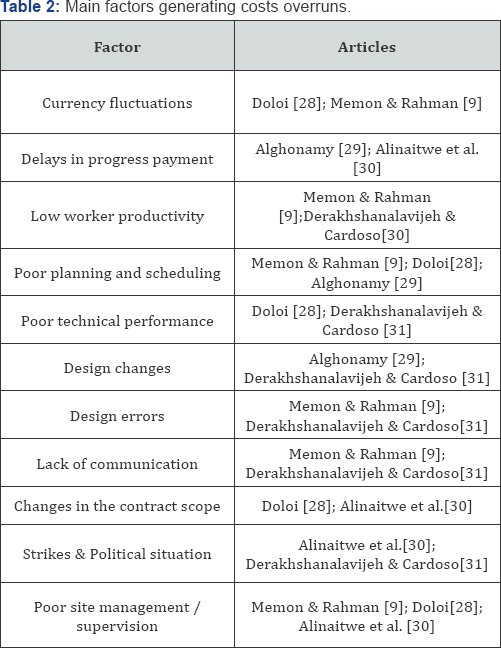A Critical Literature Review Exploring the Challenges of Research in Delays and Cost Overruns in Construction Projects- Juniper Publishers
Juniper Publishers-Journal of Civil Engineering
Abstract
Construction project delays and cost overruns
represent a constant source of concern for project developers and
several researches have been developed in order to identify causes of
these kind of deviations worldwide. In this paper, a literature review
was developed in order to identify the most significant factors that
generate overruns in construction projects and the methods applied to
identify them. The results include a synthesis of internal and external
factors, a critical evaluation of different investigations and
recommendations for future research.
Keywords: Construction projects; construction delays; construction cost overruns Introduction
Construction projects are constantly faced with the
difficulties stemming from construction delays and cost overruns,
representing a source of uncertainty for construction professionals and
project developers. In light of the large number of variables involved
Enshassi et al. [1],
it is difficult to maintain full control over the performance of civil
projects. A deep knowledge and understanding of the significant factors
that lead to delays and cost overruns, would facilitate the
establishment of actions that minimize the negative effects that can
lead to disputes and claims leading to trials or the total abandonment
of the project.
The scientific literature reports delays and overruns
as common occurrences worldwide. In India, over 40% of construction
projects are facing time overrun Iyer & Jha [2]
for groundwater construction projects of Ghana, it was reported that
75% of the projects have deviations in cost and time Frimpong et al. [3].
The average of time overrun in large construction projects in Saudi
Arabia is between 10% and 30% of the original duration Assaf &
Al-Hejji [4]. For international projects, a research conducted by Ahsan & Gunawan [5]
found that real duration exceeds overall planned in average 33.37%. For
Indonesian construction projects, Kaming, Olomolaiye, Holt & Harris
[6] found that only 54.5 percent of the projects are completed on time, and Olatunji [7]
found that in Nigeria 55 per cent of 137 analyzed projects had
overruns. The Gaza Strip, an area with complex problems and limited
resources that affect project performance, faced similar problems
reported on other countries [1]
and on the other hand, developed countries, such as the United Kingdom,
failed to meet time and cost expectations Ola wale & Sun [8]. Finally, Memon & Rahman [9] found that developing countries present considerably higher cost overruns when compared to developed countries. In Table 1 and Table 2 are exposed the most significant factors in terms of project delays and cost overruns respectively.

* W/E/M = workers/equipment/ materials.

In respect of the applied research methodology, it
generally consists on a survey for project stakeholders in order to
ascertain, in their opinion, the significant factors that lead to time
and cost deviations. After that, through descriptive statistics like
frequency and importance index, a list of the most significant factors
is established. Other methods applied consist in case studies Kaliba et
al.[10], factor analysis Doloi et al. [11], ANOVA Ahsan & Gunawan [5], KRUSKAL WALLIS Shehu Z et al. [12] and fuzzy logic to estimate the probability of delay that was also considered by Gunduz et al. [13].
Discussion
Construction is currently considered one of the most
important sectors as far as economic growth and job creation are
concerned, but frequently delays and cost overruns are reported
generating multiple problems and even the total abandon of the project.
The negative effects of this situation make the research in this topic a
need.
Many of the factors generating delays and cost
deviations are related to planning and, in light of these findings,
enough time and resources should be dedicated to the initial phases of
project life cycle. Other external factors such as: currency
fluctuations, weather or geopolitical problems remain beyond
stakeholders control and there are in some cases unpredictable. For
these factors, the focus should be on the analysis and definition of
risks that may arise during project development.
The investigation related to cost and time deviations
has to establish correlations among factors and aspects such as project
scale, business size and project type (public, private, residential,
infrastructure), contract type, among others. Other important aspect to
consider is the relationship between the different factors identified,
like which of them generate the occurrence of others and which of them
are presented simultaneously [14-31].
Conclusion
Case studies are an effective method for providing
indepth knowledge about a topic and are appropriate to identify the
causes of deviations in projects from primary sources. In this way,
research can be continued with focus on creating or identifying
mitigation measures that can benefit those involved in construction.
There is still open to research the challenge for developing a unified
methodology to deal with the problem of time and cost overruns in
construction projects. In this line, there is an essential need for a
model that allow the comparison of results, characterizing construction
projects and focused on data science, taking into account not only the
physical characteristics, but also the organization and contract
conditions, besides geographical locations, size, sector and
adjudication process.
However, in spite of the great importance of this
research topic for construction industry, the analyzed literature does
not allow the research community to compare the obtained results, and
apply corrective measures based on lessons learned in other studies.
For more open access journals please visit: Juniper publishers
For more articles please click on: Civil Engineering Research Journal


Comments
Post a Comment